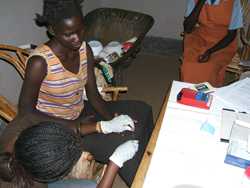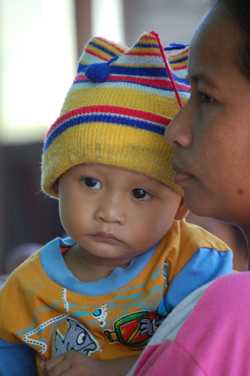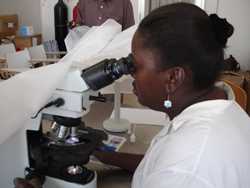Current and Future Research
CDC’s research extends from basic research and development in the field and laboratory to strategic and applied research aimed at controlling or eliminating malaria worldwide.
CDC’s malaria research goals are to
-
Optimize the mix of current interventions for malaria control.
-
Identify opportunities to integrate efforts with other initiatives.
-
Evaluate and mitigate potential threats to malaria control, including insecticide and drug resistance.
Optimize Mix of Current Interventions
Proven tools for malaria control include early treatment of malaria illness with artemisinin-based combination therapies (ACTs), intermittent preventive treatment for pregnant women (IPTp), and measures that reduce the risk of infection such as indoor residual spraying (IRS) or insecticide-treated bed nets (ITNs). Each of these has been shown to be effective at contributing to malaria control on its own.
As effective control programs expand these interventions, it is becoming increasingly important to understand how they can be deployed optimally alongside one another and on a large scale. Prevention through widespread use of ITNs or IRS, for example, might reduce the level of malaria transmission to the point that pregnant women are no longer at measureable risk of asymptomatic malaria, suggesting that IPTp interventions may no longer be needed. Scaled-up prevention of malaria transmission can also affect decisions about how best to deliver treatment for malaria illness.
-
It is critical to understand the interaction of IRS and ITNs, two core transmission reduction interventions. Understanding whether IRS, with the addition of universal ITN coverage, results in lower malaria burden, or, alternatively, whether high ITN coverage can help to reduce the number of IRS rounds needed for sustained transmission reduction can help us to invest our resources more strategically.
While both long-lasting insecticide-treated nets (LLINs) and IRS have similar efficacy in preventing malaria, it is unclear how best to integrate these interventions in a coherent malaria prevention strategy. A major question is whether LLINs and IRS have an additive effect on malaria transmission and malaria-related illness and death. CDC is now analyzing pooled Malaria Indicator Survey (MIS) datasets from President’s Malaria Initiative (PMI) countries where both IRS and universal coverage of ITNs have been implemented to answer this question. Malaria outcomes including parasitemia, rapid diagnostic test (RDT) positivity, and anemia status are being evaluated in this context while controlling for confounding factors including transmission intensity, environmental determinants, wealth index, age, maternal education, and recent treatment. Various analytic strategies including exact matching and propensity scoring are being compared via sensitivity analyses in order both to answer this key question and to develop an “optimal” toolkit for monitoring and evaluating these interventions. Once refined, code will be made available for program managers in the free statistical software package R (R Core Development Team, version 2.13.0, Vienna, Austria).
-
In Indonesia, CDC is working in three sites where the transmission of malaria ranges from near elimination to hyperendemic to try to determine the optimal interventions for each epidemiologic context. Among the interventions being evaluated are ACTs, IPTp, community-based larval interventions including larvicides and environmental management, and IRS.

A worker takes a blood sample from a mother in Oyugis, Kenya, to compare malaria levels between sprayed and non-sprayed regions. Credit: Adam Wolkon, CDC

The lives of many Indonesian children will be saved through the use of effective malaria prevention and control interventions. Credit: David Townes, CDC
Establish and Integrate New or Revisited Interventions
Along with scaling up proven interventions for malaria control, researchers are contemplating new interventions or updating previously used malaria control interventions. These include new drugs and vaccines for treatment and prevention, new diagnostic tests, innovative insecticide-treated materials, and revised systems for delivering and evaluating malaria control. Understanding how these new or revisited interventions will operate under field conditions; proving their efficacy, effectiveness and safety; and demonstrating their interaction with existing malaria control efforts will be crucial to advising endemic countries and global donors about when and where to introduce them.
-
Rapid malaria diagnostic tests have made it possible to expand laboratory diagnosis of malaria beyond health facilities with functioning microscopes to more outlying locations, even beyond the walls of remote health posts into endemic communities. Understanding the performance limitations of the current generation of rapid tests can help us decide how to deploy them most efficiently and may provide experience and evidence that can shape the next generation of diagnostic tools. Evaluating strategies based on mass screening and treatment of healthy populations could suggest how diagnosis and treatment might be used to respond to localized outbreaks of malaria transmission in settings where effective control has been achieved and may ultimately contribute to elimination.
-
The use of insecticides has evolved, along with development of long-lasting wash-resistant applications for bed nets and new formulations for use in IRS. We are looking at the durability of the net fabric to determine the impact of holes on the protective efficacy of nets and how to make nets more durable.
-
Durable wall liners (DLs) are being evaluated by CDC in western Kenya. The study is being conducted in six pairs of villages with one village in each pair randomized to receive DLs. DLs were installed in all sleeping rooms in 1,700 house structures in 2010, and preliminary analysis of the initial phase indicated that DLs reduced the incidence of new malaria infections by 38%. We continue to estimate malaria transmission through entomological measures and we are monitoring the quality of the DLs at approximately six-month intervals to determine how long they will remain effective.
-
CDC, collaborating with other PMI partners, (PMI), is evaluating the durability—both physical and insecticidal— of long-lasting insecticide treated nets (LLINs) over time in eight PMI countries so that appropriate plans can be made for net replacement. Physical durability is evaluated by counting and measuring the number and size of the holes in the nets, and insecticidal durabililty (ability to continue to kill mosquitoes) is measured by a standard cone bioassay. The insecticide content in the net fiber is measured by chemical analyses—high performance liquid chromatography, gas chromatography, or X-rays—depending on the net brand’s insecticide. To measure the insecticide content on the surface of the net fiber, colorimetric assays are used. The data collected from these evaluations will help country malaria control officials decide and plan for when to replace the nets to maintain protection against malaria. These studies can also evaluate multiple net brands to determine which net may do best in a particular setting. These evaluations follow the WHO guidance on evaluating the durability of LLINs.

Dr. Bakari Amuri, Ifakara Health Institute, and Dr. Meredith McMorrow, CDC, train health workers at Bungu Dispensary, in Rufiji District, Tanzania, to take blood samples. Credit: S. Patrick Kachur, CDC

Researchers study the effectiveness of insecticide-treated eave curtains in Kisumu District, Kenya. Credit: John Gimnig, CDC
Identify Opportunities to Integrate Efforts with other Initiatives
In addition to new resources for malaria control, many endemic countries are simultaneously rolling out programs to combat HIV/ AIDS and neglected tropical diseases, enhance health information systems and supplies management, and reinforce maternal and child health. For each of these to operate at its potential will require careful planning and collaboration, especially at the most peripheral level where most of the tasks fall to the same few health workers. Examining how interventions can be delivered and managed in integrated ways will be key to achieving sustainable progress across multiple health conditions.
-
In many parts of the malaria-endemic world, mosquito vectors also transmit other viral and parasitic diseases. Coordinating an integrated vector management policy could effectively reduce both malaria and other illnesses like lymphatic filariasis or dengue. Like malaria control programs, many other health initiatives evaluate their effectiveness through regular population surveys or routine health facility reporting. Identifying opportunities to develop integrated evaluation tools and reporting systems that may lead to broader gains for malaria control and across the public health spectrum.
-
In many parts of Africa and the South Pacific, lymphatic filariasis is transmitted by the same mosquitoes that transmit malaria. While filariasis elimination strategies are based on mass drug administration with a combination of drugs, studies have shown that vector control can accelerate the elimination of filariasis and limit the potential reintroduction of this parasitic disease to areas where it has been eliminated.

A woman in Nigeria washes her left leg and foot, swollen by lymphatic filariasis; frequent washing with soap and water helps prevent bacterial superinfection. Credit: F. Richards, The Carter Center
Conduct Research and Development in the Laboratory and the Field
Field-based investigations provide insights into mechanisms and dynamics of malaria parasite transmission, emerging trends such as drug resistance and the range and type of host immune and pathological responses to malaria. They often yield valuable specimens that provide critical information when studied further through cutting-edge bench research in well-equipped laboratories in the United States and overseas. CDC’s laboratories (augmented by state-of-the-art insectaries and animal facilities) conduct more basic and applied studies, whose findings can in turn be verified or expanded during field investigations and lead to improved or new interventions for control and prevention.
Investigate Immune Responses and Immunity
CDC, through its field-based studies and laboratory investigations, has unique biological samples available from malaria cohort studies designed to investigate the role of antibodies, cytokines, and innate immune factors in protection against both uncomplicated malaria and severe malaria with anemia and cerebral involvement. These studies include birth cohort studies conducted in Kenya and ongoing cohort studies in India, which include both Plasmodium vivax and P. falciparum infections.

An expert microscopist works at the National Institute for Public Health (Instituto Nacional de Saúde Pública) in Luanda, Angola. Credit: Julie Thwing, CDC
Collectively, these studies allow investigation of why manifestations of severe disease outcomes differ in various endemic settings (intense transmission versus seasonal transmission), how transmission pressure affects development of immune responses, and, importantly what factors determine the acquisition of clinical and parasitological immunity. These questions are being addressed using various immunologic assays and the latest molecular tools. The malaria research community is in the process of developing vaccines effective against malaria parasites in order to provide new interventions that will help control and eliminate malaria. Understanding which immune responses are active in malaria and how they are destructive to parasites is important to the rational development of vaccines. CDC investigators have undertaken ongoing field- and laboratory-based studies in this area to define the correlates of immunity for candidate vaccine antigens, which are critically important for guiding and efficiently furthering malaria vaccine development.
Characterize Genetic Contribution to Drug Resistance, Immunity, and Disease
CDC conducts ongoing investigations into the genetic complexity of malaria parasites and how this complexity and selection affects drug resistance, immunity, and disease.
The CDC malaria laboratories engaged in this malaria research are developing molecular tools and networks in the field in South America, Africa, and Southeast Asia that will monitor emergence of drug-resistant malaria parasites globally. The laboratories collect and maintain malaria parasite isolates with a wide array of defined drug-resistant properties in order to identify and characterize the molecular and biological markers of drug resistance and, also, the mechanisms by which drug resistance develops in these malaria parasites. These in vivo and in vitro adapted strains are archived and made available to qualified malaria researchers around the world. As well, CDC’s malaria program offers training to investigators in endemic countries on using molecular markers to detect and track drug-resistant parasites and in vitro methods of testing parasites for drug susceptibility.
CDC is also characterizing the genetic diversity in important malaria vaccine candidate antigens. Detection of molecular diversity in candidate vaccine antigens is elemental to the development of vaccines effective against malaria and to the determination of the best and least variable antigens that can serve as stable targets of immunity and for vaccine development.
A person’s genetic factors can influence dramatically the development and outcomes of severe disease states in malaria infections as well as the acquisition of immune status. We are taking advantage of our laboratory facilities and materials from our field-based cohort studies to identify potential host genetic factors associated with susceptibility to or protection from severe malarial anemia and cerebral malaria or with protection from infection. Recent advances in human genome research have opened up new opportunities for identifying host genetic factors associated with severe disease outcomes and innate resistance factors that protect against morbidity and mortality due to malaria infections.
These studies in parasite and human genetics also help to develop suitable molecular markers that could be used for tracking parasite populations associated with severe disease outcomes.
Development and Evaluation of Vaccines, Host-Parasite Biology, and Nonhuman Primate Models
The development of an effective malaria vaccine faces major challenges. Most vaccine development efforts are targeted against Plasmodium falciparum, the most serious and deadly malaria parasite. These vaccine efforts must take into account the genetic diversity of both the parasite and the human host and strive to provide effective immunity against the different stages of the life cycle. With a growing call for greater efforts to tackle malaria elimination, efforts are increasing to produce vaccines that target P. vivax, which must take into consideration features such as relapses and hypnozoite stages.
CDC scientists have an ongoing malaria vaccine development and evaluation program that develops models of human malaria in small New World monkeys and uses these nonhuman primate models to investigate the immunogenicity and protective efficacy of malaria vaccine candidates developed by CDC and other scientific groups globally. These primate malaria models are the only methods available to test the potential efficacy of human malaria vaccines prior to expensive human clinical trials.
Other studies of the biology of the malaria parasites using these nonhuman primate models and bench research
-
aim to gain a better understanding of the relationships between malaria parasites, mosquito vectors, and vertebrate hosts, in order to improve or facilitate the development of new methods to combat malaria such as vaccines or new drugs.
-
allow the modeling of parasite-host relationships with regard to immunity, pathology, and response and susceptibility to old and newly developed antimalarial drugs.
New isolates and strains of malaria parasites are collected, adapted to laboratory culture or nonhuman primates, and tested using the latest available treatments. These nonhuman primate hosts of human malarias and of the simian malaria parasites also offer faithful models to investigate mechanisms and treatments for severe pathology associated with malaria infections such as anemia, cerebral malaria, and malaria in pregnancy.
Rapid Diagnostic Tests

In Liberia, a worker uses an RDT to test a blood sample for malaria. Credit: Bob Wirtz, CDC
The malaria laboratories at CDC in conjunction with WHO and the Foundation for Innovative New Diagnostics (FIND) conduct extensive laboratory-based evaluations on the performance of commercial RDTs on the global market as well as investigation into a variety of other issues connected with the development and deployment of these new diagnostic tests.
More on: Rapid Diagnostic Tests.
Evaluate and mitigate potential threats to malaria control
Along with the successes of malaria prevention and control have come potential threats to the continued effectiveness of certain existing interventions. The malaria parasite previously has developed resistance to antimalarials that contained only one drug or drug combinations with the same mode of action.
Artemisinin-based combination therapies (ACTs) combine two antimalarial drugs with different half-lives and modes of action. It is expected that combination therapy will reduce the chances that parasites will develop resistance, but good surveillance must be undertaken to ensure that any resistance that develops is identified early and contained. CDC is supporting therapeutic efficacy studies in many countries using a protocol standardized by the WHO to evaluate the efficacy of first- and second-line therapies. These studies, conducted every two years in most countries, will help to identify any development of resistance early, permitting a policy change to a new antimalarial.
Top of PageResistance to several antimalarial drugs has originated from the Greater Mekong Subregion. Recent documentation of the declining efficacy of mefloquine-artesunate among Burmese migrants in western Thailand has raised concerns that artemisinin resistance has already spread to the Thai-Burma border. CDC staff are working along the border to understand migrant workers' access to effective drugs. It is expected that this qualitative approach to analyzing healthcare–seeking patterns of migrant workers will help to improve programs to extend effective treatment to hard-to-reach populations in the area and contribute to containing any outbreak of ACT resistance.
Resistance of malaria vectors to pyrethroids, the only class of insecticides used on ITNs and one of the least expensive classes of insecticide used for IRS, has been spreading throughout Africa over the last decade. Although there is the option to switch to a different class of insecticides with IRS, albeit at a higher cost, there are currently no alternatives to pyrethroids on ITNs. CDC researchers are working to evaluate the effectiveness of ITNs in an area of substantial pyrethroid resistance, to provide epidemiologic confirmation that ITNs in this area do or do not continue to protect users from malaria infection. Although no non-pyrethroid ITNs exist, several manufacturers have developed combination nets that incorporate a synergist (a chemical that blocks the resistance mechanisms in the malaria vectors) into the net fibers to render vectors susceptible to pyrethroids again, resulting in their death or repellency from the pyrethroid. These combination nets are being evaluated entomologically and if proven effective at reducing infectious mosquito bites, they will be evaluated epidemiologically to show whether they improve malaria prevention in areas with substantial pyrethroid resistance.
Top of Page- Page last reviewed: October 30, 2015
- Page last updated: October 30, 2015
- Content source:


 ShareCompartir
ShareCompartir